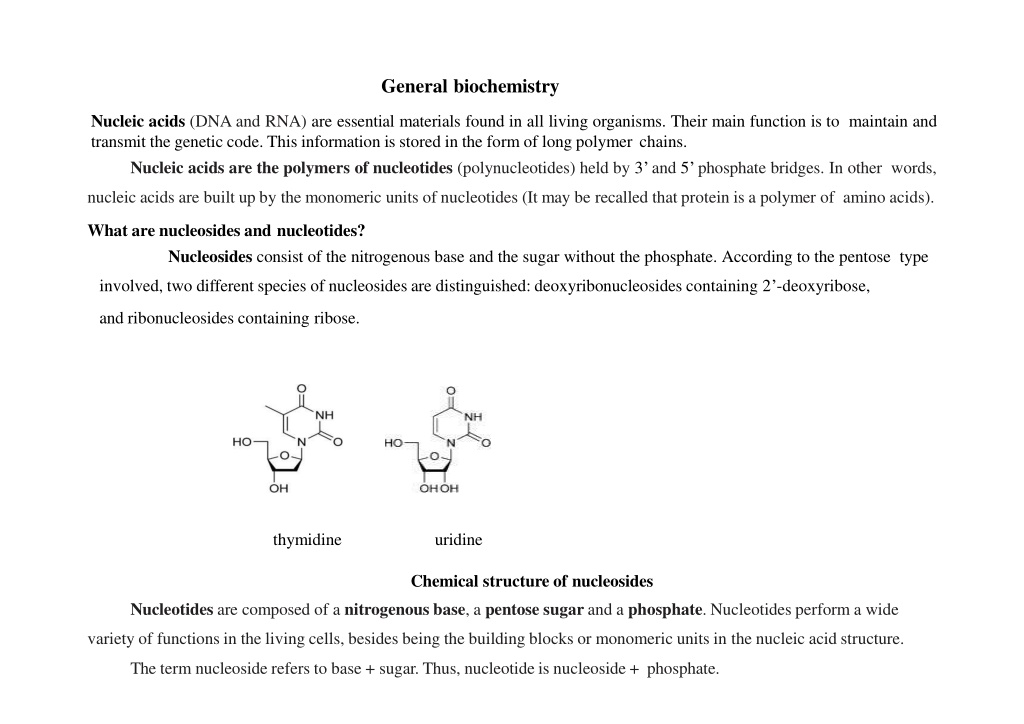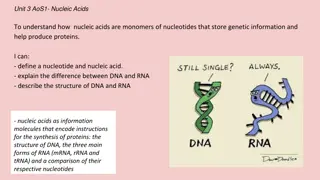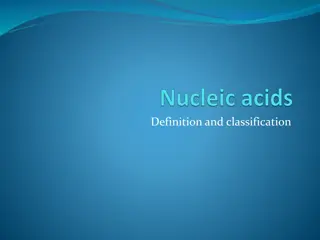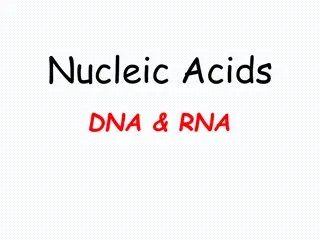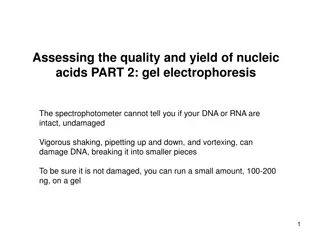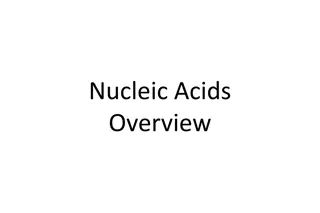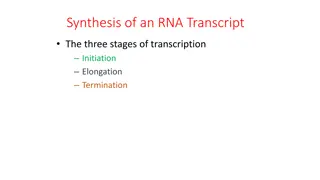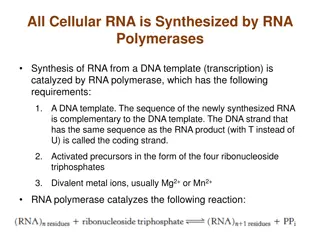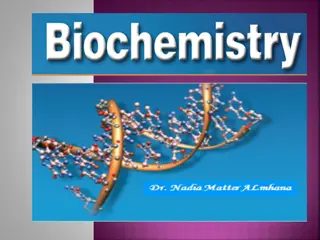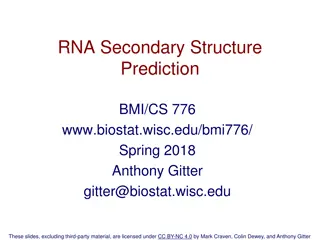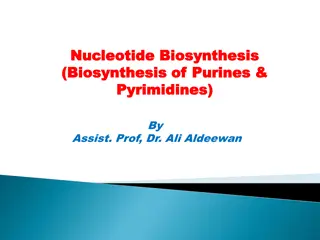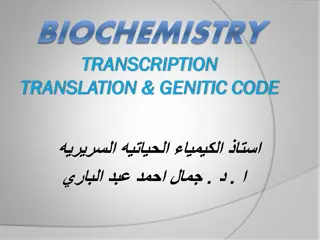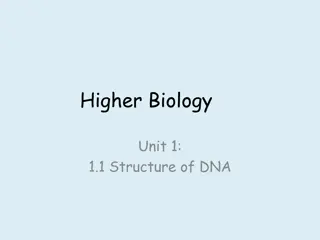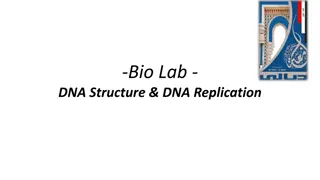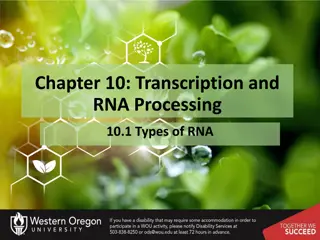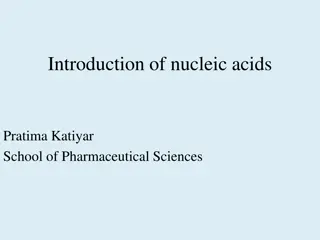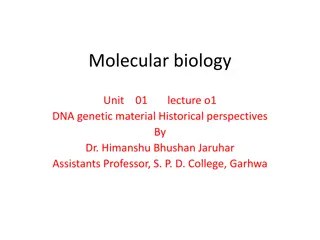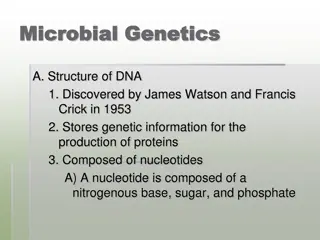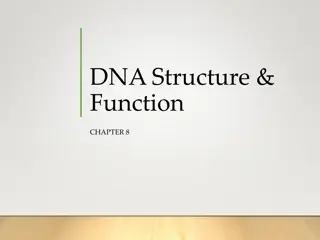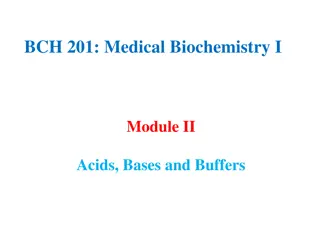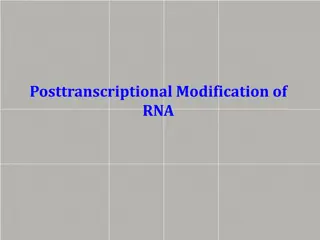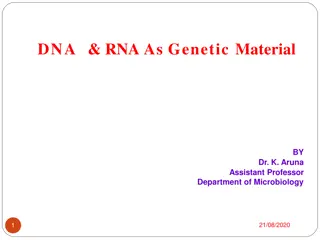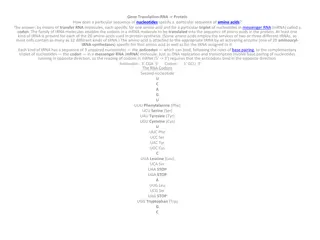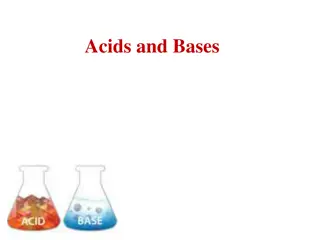Understanding Nucleic Acids: DNA, RNA, and Nucleotides
Nucleic acids, essential for all organisms, store genetic information as long polymer chains of nucleotides. Nucleosides contain bases and sugars, while nucleotides include a phosphate. Purines and pyrimidines are the aromatic bases in nucleotides, with DNA having A, G, C, T and RNA having A, G, C, U bases. The sugars in nucleic acids differ between RNA (D-ribose) and DNA (D-deoxyribose). Learn about the structural elements, nomenclature, and functions of nucleotides in living cells.
Download Presentation

Please find below an Image/Link to download the presentation.
The content on the website is provided AS IS for your information and personal use only. It may not be sold, licensed, or shared on other websites without obtaining consent from the author. Download presentation by click this link. If you encounter any issues during the download, it is possible that the publisher has removed the file from their server.
E N D
Presentation Transcript
General biochemistry Nucleic acids (DNA and RNA) are essential materials found in all living organisms. Their main function is to maintain and transmit the genetic code. This information is stored in the form of long polymer chains. Nucleic acids are the polymers of nucleotides (polynucleotides) held by 3 and 5 phosphate bridges. In other words, nucleic acids are built up by the monomeric units of nucleotides (It may be recalled that protein is a polymer of amino acids). What are nucleosides and nucleotides? Nucleosides consist of the nitrogenous base and the sugar without the phosphate. According to the pentose type involved, two different species of nucleosides are distinguished: deoxyribonucleosides containing 2 -deoxyribose, and ribonucleosides containing ribose. thymidine uridine Chemical structure of nucleosides Nucleotides are composed of a nitrogenous base, a pentose sugar and a phosphate. Nucleotides perform a wide variety of functions in the living cells, besides being the building blocks or monomeric units in the nucleic acid structure. The term nucleoside refers to base + sugar. Thus, nucleotide is nucleoside + phosphate.
Structural elements of the most common nucleotides Purines and pyrimidines bases: The nitrogenous bases found in nucleotides (and, therefore, nucleic acids) are aromatic compounds. The bases are two types: purines and pyrimidines as shown their structure in below figure. purines
adenine guanine pyrimidines thymine uracil cytosine . Structures of nitrogenous bases. Major bases in nucleic acids: The structures of major purines and pyrimidines found in nucleic acids are shown in above figure. DNA contains: Purine bases namely: adenine (A) and guanine (G). Pyrimidine bases namely: cytosine (C) and thymine (T) RNA contains: Purine bases namely: adenine (A) and guanine (G). Pyrimidine bases namely: cytosine (C) and uracil (U). Sugars of nucleic acids:
The five carbon monosaccharides (pentoses) are found in the nucleic acid structure. RNA contains D-ribose while DNA contains D-deoxyribose. Ribose and deoxyribose differ in structure at C2. Deoxyribose has one oxygen less at C2 compared to ribose as ehown in below figure. Phosphate: The inorganic acid H3PO4 (phosphoric acid) gives the nucleic acids an overall net negative charge. Most of the interactions between the DNA and proteins are with the phosphate groups.
Nomenclature of nucleotides: The addition of a pentose sugar to base produces a nucleoside. If the sugar is ribose, ribonucleosides are formed. Adenosine, guanosine, cytidine and uridine are the ribonucleosides of A, G, C and U respectively. If the sugar is a deoxyribose, deoxyribonucleosides are produced. Adenosine, guanosine, cytidine and Thymine are the ribonucleosides of A, G, C and T respectively. Note: Add to purine bases end (in NSs) ..sine: adenosine and guanosine. Add to pyrimidine bases end ( in NSs) ..dine: cytidine, uridine, deoxythymidine. Use the same names in NTs with momo, di and tri phosphate. For examples: adenosine monophosphate, guanosine triphosphate, deoxythymidine monophosphate.
The term mononucleotide is used when a single phosphate moiety is added to a nucleoside. Thus adenosine monophosphate (AMP) contains adenine + ribose + phosphate. While dAMP contains adenine + deoxyribose + phosphate. The principal bases, their respective nucleosides and nucleotides found in the structure of nucleic acids are given in below figure.
What is DNA? DNA is a polymer of deoxyribonucleotides (or simply deoxynucleotides). It is composed of monomeric units namely deoxyadenylate (dAMP), deoxyguanylate (dGMP), deoxycytidylate (dCMP) and deoxythymidylate (dTMP). Propritie of DNA: 1. The structure of DNA is double helical strands (helix) 2. The deoxyribose sugar consist his backbone
3. It is a right handed double helix. 4. It consists of two polydeoxyribonucleotide chains (strands) 5. The strands are twisted around each other on a common axis. 6. . The two strands are antiparallel, one strand runs in the 3 to 5 direction while the other in 3 to 5 direction. The two strands are held together by hydrogen bonds formed by complementary base pairs. 7. 8. Complementary base pairing in DNA is Thymine pairs with adenine by 2 hydrogen bonds and Cytosine pairs with guanine by 3 hydrogen bonds. 9. The A = T and G = C.
What is RNA? RNA is a polymer of ribonucleotides held together by 3 , 5 -phosphodiester bridges. Although RNA has certain similarities with DNA structure and they have specific differences in: 1. Pentose sugar : The sugar in RNA is ribose in contrast to deoxyribose in DNA. 2. Pyrimidine bases : RNA contains the pyrimidine uracil in place of thymine (in DNA). 3. Single strand : RNA is usually a single stranded polynucleotide. 4.Due to the single-stranded nature, there is no specific relation between purine and pyrimidine contents. Thus the guanine content is not equal to cytosine (as is the case in DNA). Types of RNA: The three major types of RNAs with their respective cellular composition are given below: 1.Messenger RNA (mRNA) : The mRNA is synthesized in the nucleus (in eukaryotes) and It participates in the information transfer from DNA (replication) to the site of protein synthesis (on ribosome). 2.Transfer RNA (tRNA) : It participates in the activation of amino acids, their transport to ribosome, and collecting the polypeptides from amino acids on ribosome. 3.Ribosomal RNA (rRNA) : Form of RNA in the cytoplasm (or mitochondria), It participates to link amino acids with others to form protein.
Structure and levels of organization of nucleic acids: Nucleic acids possess primary, secondary, tertiary and quarternary levels of organization. Physico-chemical properties of nucleic acids: Physico-chemical properties of nucleic acids are primarily determined by their high molecular mass and by the level of structural organization. Specific features of nucleic acids show up in their: colloidal and osmotic properties, high viscosity and density of solutions, optical properties, aptitude to denaturation. In solution, the molecules of nucleic acids exist as polyanions with distinctly pronounced acidic properties.
